Bevil Grenville
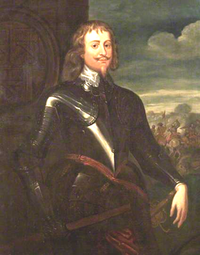

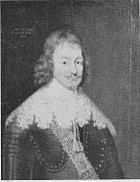
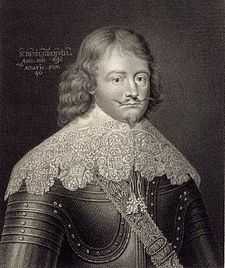
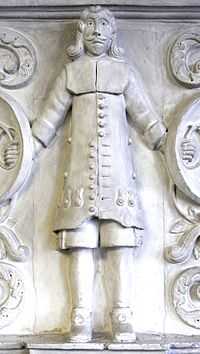

Sir Bevil Grenville (1596 – 5 July 1643) was MP for Cornwall 1621–1625 and 1640-42, and for Launceston 1625–1629 and 1640. He was a Royalist soldier in the Civil War and was killed in action in heroic circumstances at the Battle of Lansdowne in 1643.
Early life
Grenville was born near Withiel, west of Bodmin, Cornwall, the son of Sir Bernard Grenville by his wife Elizabeth Bevil, and was a grandson of Sir Richard Grenville (1542–1591), the heroic Elizabethan naval captain, explorer, and soldier. The Grenville family had for centuries been lords of the manors of Stowe in the parish of Kilkhampton in Cornwall, and of Bideford in Devon.[citation needed] He was educated at Exeter College, Oxford.[2]
Political career
Granville was elected Member of Parliament for Cornwall in 1621 and remained so until 1625.[3] Under King Charles I he became MP for Launceston in 1625 where he remained until King Charles decided to rule without parliament in 1629.[4] In parliament, Grenville supported Sir John Eliot and the opposition, and his intimacy with Eliot was lifelong.[2] In 1639, however, he appeared as a royalist going to the Bishop's War against Scotland in the train of King Charles I. The reason for this change of allegiance is unknown, but Grenville's honour was above suspicion and he must have been convinced that he was doing right. At any rate he was a very valuable recruit to the royalist cause, being "the most generally loved man in Cornwall".[2] When parliament reassembled for the Short Parliament in April 1640, Grenville was chosen as MP for Launceston again. In November he was re-elected MP for Cornwall for the Long Parliament.[5] He was disabled in 1642 for supporting the Royalists.[citation needed]
Civil War
At the outbreak of the Civil War, Grenville together with others of the gentry not only proclaimed the king's Commission of Array at Launceston assizes, but also persuaded the grand jury of the county to declare their opponents guilty of riot and unlawful assembly, whereupon the posse comitatus was called out to expel them. Under the command of Sir Ralph Hopton, Sir Bevil took a distinguished part in the Battle of Braddock Down and, at Stratton (16 May 1643), where the parliamentarian Henry Grey, 1st Earl of Stamford was completely routed by the Cornishmen, he led one of the storming parties which captured Chudleigh's lines.[6] He then led his men on a victorious march through Devon into Somerset.[citation needed]
Death at Lansdowne

A month later, the endeavour of Hopton to unite with Prince Maurice and the Marquess of Hertford from Oxford brought on the Battle of Lansdowne (1643), near Bath in Somerset. Here Grenville was killed on 5 July 1643 at the head of the Cornish infantry as it reached the top of Lansdown Hill.[2] He received a blow to the head with a pole-axe and was taken to the rectory at nearby Cold Ashton where he died.[7] His death was a blow from which the king's cause in the West never recovered, for he alone knew how to handle the Cornishmen. Hopton they revered and respected but Grenville they loved as peculiarly their own commander and, after his death, there is little more heard of the reckless valour which had won Stratton and Lansdown.[2]
Family
He married Lady Grace Smythe, daughter of Sir George Smythe, by whom he had fourteen children, one of whom was John Grenville, 1st Earl of Bath (1628–1701). The other children were by Royal Warrant of Precedence granted the rank and title of Earl's children by King Charles II on 20 August 1675, in recognition of their father's services.[8]
Monuments
Mural monument, Kilkhampton Church
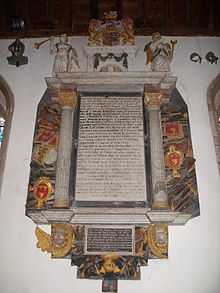
According to the Encyclopædia Britannica Eleventh Edition: "Grenville was the type of all that was best in royalism. He was neither rapacious, drunken nor dissolute, but his loyalty was unselfish, his life pure and his skill no less than his bravery unquestionable." His giant servant Anthony Payne, about whom Alan M. Kent wrote a poem Oogly es Sin: the Lamentable Ballad of Anthony Payne, Cornish Giant,[9] brought his body back to Kilkhampton.[10] His Cornish soldiers refused to fight under any other leader and returned home, carrying the body of Sir Bevil. It was buried in a tomb in Kilkhampton Church.[11]
Sir Bevil Grenville's Monument, Lansdown Hill
Sir Bevil Grenville's Monument was erected in his memory on the field of Lansdown[2] to commemorate the heroism and that of his Cornish pikemen at the Battle of Lansdown.
See also
- John Granville, 1st Earl of Bath, his son
- Sir Richard Grenville, 1st Baronet
- The Gear Rout
- William Scawen
Notes
- ↑ Delderfield 1968, p. 123.
- ↑ 2.0 2.1 2.2 2.3 2.4 2.5 Chisholm 1911, p. 580.
- ↑ Willis 1750, pp. 176, 188, 198.
- ↑ Willis 1750, pp. 209, 219.
- ↑ Willis 1750, pp. 230, 241.
- ↑ Chisholm 1911, p. 580 cites Clarendon, vii., 89
- ↑ Barratt 2005, pp. 53–56.
- ↑ The London Gazette: no. 1020. p. 2. 30 August 1675.
- ↑ BBC staff (8 January 2008). "Anthony Payne: a one man stage play written by Dr Alan M Kent". BBC.
- ↑ Mee, Arthur (1937). Cornwall. London: Hodder & Stoughton. pp. 98–99.
- ↑ Stoyle, Mark (2002). West Britons. University of Exeter Press.
References
- Barratt, John (2005). The civil war in the south west. Bernsley: Pen & Sword Military. pp. 53–56. ISBN 1-84415-146-8.
- Delderfield, Eric R. (1968). West Country Historic Houses and their Families:Cornwall, Devon and West Somerset 1. Newton Abbot Newton Abbot: David and Charles. p. 123.
- Willis, Browne (1750). Notitia Parliamentaria, Part II: A Series or Lists of the Representatives in the several Parliaments held from the Reformation 1541, to the Restoration 1660 .... London. pp. 176, 188, 198, 209, 219, 230, 241.
- Attribution
 This article incorporates text from a publication now in the public domain: Chisholm, Hugh, ed. (1911). "Grenville, Sir Bevil". Encyclopædia Britannica 12 (11th ed.). Cambridge University Press. p. 580
This article incorporates text from a publication now in the public domain: Chisholm, Hugh, ed. (1911). "Grenville, Sir Bevil". Encyclopædia Britannica 12 (11th ed.). Cambridge University Press. p. 580
Further reading
 Firth, C.H. (1890). "Grenville, Bevil". In Stephen, Leslie; Lee, Sidney. Dictionary of National Biography 23. London: Smith, Elder & Co. pp. 110–112.
Firth, C.H. (1890). "Grenville, Bevil". In Stephen, Leslie; Lee, Sidney. Dictionary of National Biography 23. London: Smith, Elder & Co. pp. 110–112. - Lloyd (1668). Memoirs of Excellent Personages.
- Gardiner, S. R.. History of the English Civil War: (1642–1644) 1. pp. 80, 81 99 100 160 200–202. (Gardiner spells Grenville "Sir Bevil Grenvile")
- "Battlefield History Resources".
| Parliament of England | ||
|---|---|---|
| Preceded by Richard Carew John St Aubyn |
Member of Parliament for Cornwall 1621–1625 With: John Arundell 1621–1622 William Coryton 1624–1625 |
Succeeded by Sir Robert Killigrew Charles Trevanion |
| Preceded by Sir Francis Crane Miles Fleetwood |
Member of Parliament for Launceston 1625–1629 With: Richard Scott |
Succeeded by Parliament suspended until 1640 |
| Preceded by Parliament suspended since 1629 |
Member of Parliament for Launceston 1640 With: Ambrose Manaton |
Succeeded by Ambrose Manaton William Coryton |
| Preceded by William Godolphin Richard Buller |
Member of Parliament for Cornwall 1640–1642 With: Alexander Carew |
Succeeded by Hugh Boscawen Nicholas Trefusis |